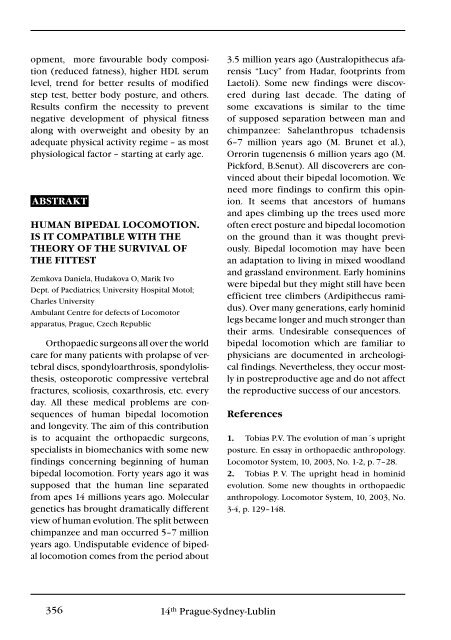3+4+Supplementum/2012 - Společnost pro pojivové tkáně
3+4+Supplementum/2012 - Společnost pro pojivové tkáně
3+4+Supplementum/2012 - Společnost pro pojivové tkáně
- TAGS
- www.pojivo.cz
You also want an ePaper? Increase the reach of your titles
YUMPU automatically turns print PDFs into web optimized ePapers that Google loves.
opment, more favourable body composition<br />
(reduced fatness), higher HDL serum<br />
level, trend for better results of modified<br />
step test, better body posture, and others.<br />
Results confirm the necessity to prevent<br />
negative development of physical fitness<br />
along with overweight and obesity by an<br />
adequate physical activity regime – as most<br />
physiological factor – starting at early age.<br />
aBSTRakT<br />
HuMan BiPedal lOCOMOTiOn.<br />
iS iT COMPaTiBle wiTH THe<br />
THeORY Of THe SuRViVal Of<br />
THe fiTTeST<br />
Zemkova Daniela, Hudakova O, Marik Ivo<br />
Dept. of Paediatrics; University Hospital Motol;<br />
Charles University<br />
Ambulant Centre for defects of Locomotor<br />
apparatus, Prague, Czech Republic<br />
Orthopaedic surgeons all over the world<br />
care for many patients with <strong>pro</strong>lapse of vertebral<br />
discs, spondyloarthrosis, spondylolisthesis,<br />
osteoporotic compressive vertebral<br />
fractures, scoliosis, coxarthrosis, etc. every<br />
day. All these medical <strong>pro</strong>blems are consequences<br />
of human bipedal locomotion<br />
and longevity. The aim of this contribution<br />
is to acquaint the orthopaedic surgeons,<br />
specialists in biomechanics with some new<br />
findings concerning beginning of human<br />
bipedal locomotion. Forty years ago it was<br />
supposed that the human line separated<br />
from apes 14 millions years ago. Molecular<br />
genetics has brought dramatically different<br />
view of human evolution. The split between<br />
chimpanzee and man occurred 5–7 million<br />
years ago. Undisputable evidence of bipedal<br />
locomotion comes from the period about<br />
356 14 th Prague-Sydney-Lublin<br />
3.5 million years ago (Australopithecus afarensis<br />
“Lucy” from Hadar, footprints from<br />
Laetoli). Some new findings were discovered<br />
during last decade. The dating of<br />
some excavations is similar to the time<br />
of supposed separation between man and<br />
chimpanzee: Sahelanthropus tchadensis<br />
6–7 million years ago (M. Brunet et al.),<br />
Orrorin tugenensis 6 million years ago (M.<br />
Pickford, B.Senut). All discoverers are convinced<br />
about their bipedal locomotion. We<br />
need more findings to confirm this opinion.<br />
It seems that ancestors of humans<br />
and apes climbing up the trees used more<br />
often erect posture and bipedal locomotion<br />
on the ground than it was thought previously.<br />
Bipedal locomotion may have been<br />
an adaptation to living in mixed woodland<br />
and grassland environment. Early hominins<br />
were bipedal but they might still have been<br />
efficient tree climbers (Ardipithecus ramidus).<br />
Over many generations, early hominid<br />
legs became longer and much stronger than<br />
their arms. Undesirable consequences of<br />
bipedal locomotion which are familiar to<br />
physicians are documented in archeological<br />
findings. Nevertheless, they occur mostly<br />
in postre<strong>pro</strong>ductive age and do not affect<br />
the re<strong>pro</strong>ductive success of our ancestors.<br />
References<br />
1. Tobias P.V. The evolution of man´s upright<br />
posture. En essay in orthopaedic anthropology.<br />
Locomotor System, 10, 2003, No. 1-2, p. 7–28.<br />
2. Tobias P. V. The upright head in hominid<br />
evolution. Some new thoughts in orthopaedic<br />
anthropology. Locomotor System, 10, 2003, No.<br />
3-4, p. 129–148.

















